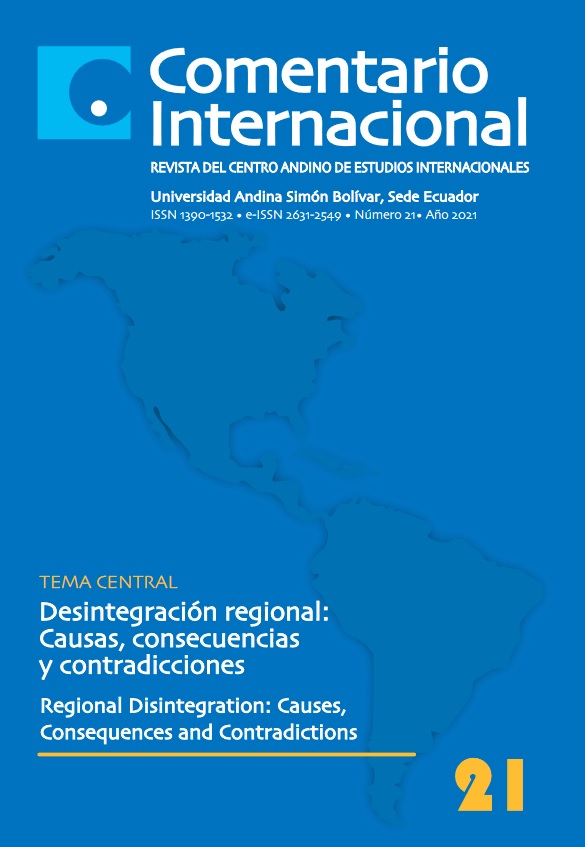South American Regional Integration: From Adolescence to Maturity
DOI:
https://doi.org/10.32719/26312549.2021.21.7Keywords:
integration, regionalism, South Amercia, cooperation, Latin America, multi- level governance, supranationalityAbstract
Along its history, the South American subcontinent has demonstrated strong wishes oriented to regional integration, and particularly starting from 1960 with the foundation of the “Asociación Latinoamericana de Libre Comercio” (ALALC). However, until nowadays, the main actors in the continental landscape keep being the national states, while the regional organizations created until now have become more or less effective spaces of dialogue between countries or even reached their complete failure. The present article takes as its main objective that of demystify those that I consider “false obstacles” to regional integration, pointing then out those which I consider real limits hindering a concrete, deep and mature cooperation between south American countries and, finally, proposing some possible solutions for south American regional integration to pass from its current “adolescence” to a complete maturity.
Downloads
References
Alexander, Jeffrey. Trauma: A Social Theory. Cambridge, UK: Polity Press, 2012. Acuerdo General sobre Aranceles Aduaneros y Comercio (GATT de 1947). Abril de 1947. https://bit.ly/3LkT3aY.
Behr, Timo, y Juka Jokela. Regionalism & Global Governance: The Emerging Agenda. París: Notre Europe, 2011. https://bit.ly/3JcnbCN.
Braanen Sterri, Aksel, ed. Global Citizen: Challenges and Responsibilities in an Interconnected World. Rotterdam: Sense Publishers, 2014.
Comisión Europea, Standard Eurobarometer 91: Results. Bruselas: Comisión Europea, 2019.
Da Silva Bichara, Julimar. “Integración latinoamericana: De ALALC al Mercosur”. Mediterráneo Económico 22: 261-9. https://bit.ly/40hLgyL.
Derecho Ambiente y Recursos Naturales, ed. Diagnóstico de la situación de la participación ciudadana en Suramérica: Propuesta para la participación ciudadana en Unasur. Los casos de Bolivia, Brasil, Colombia, Ecuador, Perú. Lima: Asociación Ambiente y Sociedad / Centro de Derechos Económicos, Sociales y Culturales / Centro de Estudios para el Desarrollo Laboral y Agrario / Derecho Ambiente y Recursos Naturales / Instituto Brasileiro de Análises Sociais e Econômicas, 2014. https://bit.ly/3ZLnA6q.
Judis, John. The Nationalist Revival: Trade, Immigration, and the Revolt against Globalization. Nueva York: Columbia Global Reports, 2018.
Malamud, Andrés, y Philippe Schmitter. “The Experience of the European Integration and the Potential for Integration in South America”. Institut Barcelona d’Estudis Internacionals. Documento de trabajo 6, 2007. https://bit.ly/407EbkH.
Oropeza, Janet, y Marine Perron. Citizen Participation in Latin America: Innovations to Strengthen Governance. Lima: Evidence and Lessons from Latin America, 2013. https://bit.ly/3ZIdfIg.
Ramírez Gallegos, Jacques. Hacia el Sur: La construcción de la ciudadanía suramericana y la movilidad intrarregional. Quito: CELAG, 2016.
Sassen, Saskia. “The Participation of States and Citizens in Global Governance”. Indiana Journal of Global Legal Studies 10, n.° 1 (2003): 5-28. https://doi.org/10.2979/gls.2003.10.1.5.
Stromquist, Nelly. “Theorizing Global Citizenship: Discourses, Challenges and Implications for Education”. Inter-American Journal of Education for Democracy 2, n.° 1 (2009): 6-29. https://bit.ly/3LlXyCh.
Downloads
Published
How to Cite
Issue
Section
License

This work is licensed under a Creative Commons Attribution-NonCommercial 4.0 International License.
Authors who publish in this journal accept the following conditions:
1. The authors keep the copyright and assign to the journal Comentario Internacional the right of the first publication, with the work registered with the attribution license of Creative Commons, which allows third parties to use what is published whenever they mention the authorship of the work and the first publication in this journal.
2. Authors can make other independent and additional contractual arrangements for the non-exclusive distribution of the article published in this journal (eg, include it in an institutional repository or publish it in a book) provided they clearly indicate that the work was published for the first time in Comentario Internacional.







